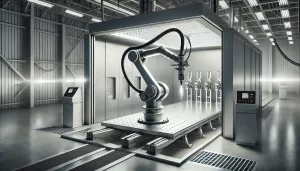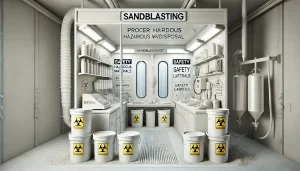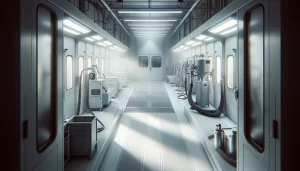What is the difference between paint and powder coat?
The truth to whether to powder coat or spray paint a metal surface, is that both solutions offers different advantages. However, before you can make a decision, you must first understand the underlying question: what is the difference between powder coating and painting?
How Does Powder Coating Work?
In the color finishing process known as powder coating, powder is utilized in place of paint. To create a color coat, the powder is heated and sprayed over the desired surface. The powder used in this method can be made from a variety of materials, including acrylic, polyester, epoxy, and polyurethane. Compared to spray painting, powder coating produces a finish that is thicker and more uniform. It should be noted that spray cans for powder coat are available for light-duty applications.
Examples of powder coating can be seen on a wide variety of common household items and equipment, including tables, lamp vases, refrigerators, washing machines, and stoves. In the last stages of auto manufacturing, powder coating is now extremely frequent.
Powder coating can be accomplished using either thermoplastics or thermosets. The former is a chemical-free procedure that uses heat to transform the powder into a thick, solid layer. With thermosets, chemical additives interact with the powder during the application stage. The outcome of thermoplastic and thermoset powder coatings is nearly equal. In both methods, the powder is heated to generate the desired color finish on a specified surface.
Learn more about Powder Coating
Read more in our article where in we answer the FAQ regarding Powder Coating
The key differences between powder coating and spray paint
The main distinction between powder coating and conventional liquid paint is that powder coating doesn’t require a solvent to maintain the liquid state of the filler and binder components. Electrostatically applied powder coating is heated to cure.
This enables the powder to flow and creates a sort of skin on the object to which it is being applied. Powder coating is used to produce a hard finish that is thought to be more durable than traditional paint and is available as a thermoplastic or thermoset polymer.
1. Cost Efficiency
When economic concerns are considered, the fundamental advantage of the powder coating method is its efficiency. With a general transfer efficiency of 60%, nearly two-thirds of the powder utilized for a specific application is used for its intended purpose. Paint, on the other hand, has a transfer efficiency of just 30-35%, resulting in the waste of two-thirds of the paint used for a given application.
All is not lost with powder applications, even when you consider the remaining amounts. The portion of powder that is left over after a powder coat is finished can be collected and used again in the subsequent cycle. Spray paint cannot be conserved in this way since it expands into nothing if it misses its aim the first time.
2. Safety
Powder coating is a safer procedure than spray painting because the active substance polymer powder is inert and thus free of toxins. In contrast, paint typically contains hazardous solvents and volatile chemical compounds that can be deadly if inhaled.
While wearing protective equipment is required while applying powder coatings, the process itself is often cleaner and devoid of health concerns. However, it is critical to avoid getting the powder on your skin, which is simple due to the tiny amount of overspray produced by the process.
3. Environmental Friendliness
The benefits of powder’s eco-friendliness go far beyond the application procedure itself. Powder polymers do not emit greenhouse gases when not in use because they do not contain any toxins or volatile organic compounds. The choice is particularly easy on landfills because most of a given powder supply is finally used. Spray paint, on the other hand, releases poisons into the atmosphere with each application.
4. Mechanical Convenience
Powder coatings are stronger and more flexible than spray painted finishes in terms of mechanical properties. For starters, a powder finish provides a thicker layer that is more resistant to cracking and peeling. Powder finishes are also more flexible, making them a better choice for goods that alter shape as well as those with moving parts.
Powder coatings’ flexibility makes them a great choice for transportation equipment that is subject to continual movement and vibration. Powder coat finishes have also been demonstrated to be more resistant to pebbles, flying debris, and other hazards kicked up by a moving vehicle’s tires.
5. Productivity
Due to the quick surface curing of powder polymers, powder coatings also aid in accelerating the production process. In contrast to paint, which may take days to completely dry, powder takes 20 minutes or less. Even before it has completely cooled down after its time in the oven, a powder coated part might eventually be put to use.
The method of applying powder coats is increasingly recognized as a vital skill at manufacturing plants, where the practice is frequently taught to personnel. This is due to the longevity and streak-free quality of powder coats.
6. Color Accessibility
Wet paints have the advantage of displaying their final, dry state hues right from the outset when it comes to color matching. This allows for more accurate paint mixing and matching, as well as the creation of colours that are somewhat off the basic color scale.
Any supplier of wet paint can readily blend primary and secondary colors to produce an exact match of a specific hue. Alternatively, the supplier could mix in black or white to match the tint, tone, or highlight of a specific color.
The color of a specific color depends on the polymers that are broken down to create the powder when mixing powder colors, which requires a specialized production process. Consequently, it may be challenging to predict in advance the hue of a blended color. In contrast to liquid paints, which have blending capabilities, diverse powders will not combine to generate a single, consistent hue when blended. Instead, a speckled combination of colors will form when powders mix into one.
7. Reliability
When it comes to metal surfaces, a paint or powder finish serves two functions. On the one hand, the coat is intended to be aesthetically pleasing, particularly if the surface is part of a commercial object such as a household appliance or automobile. However, the protective features of paint and powder coatings, which shield metal surfaces from the corrosive impacts of external factors, are more significant.
Metal can rust in areas if left exposed to water or moisture. In the most heavily rusted locations, holes can emerge within the metal surface. A strong coat of paint or powder keeps these corrosive effects at bay on metal surfaces, but only for as long as the finish is maintained. Powder coatings, which are harder and more durable than paint applications, will often provide superior, longer-lasting protection to the surfaces of metal-bodied objects.
Powder coating colors also persist longer due to the retentive qualities of polymers, which generally resist the chalking effects of moisture, heat, and UV radiation. Paints, on the other hand, progressively degrade in resins and fade after prolonged contact to sunlight, moisture, and heat. Polyester-based powders provide the best chalking resistance.
8. Texture Differences
Each method is better suited to a specific texture. While both can help you achieve a glossy finish, liquid paint is considerably easier to use. Thin powder coats are more grainy and provide the feel of orange skin. The smoother the texture, the thicker the coat.
The intricacy of the process will vary depending on the type of finish you want. Powder coating and painting are two options.
Is powder coating better than paint?
Powder coating is preferable if you require a long-lasting protective finish on your metal piece. Painting is preferable if you need to paint your metal thing cheaply. Simply said, there are no winners in this conflict. Which one is best for you will be determined by the type of application, the products involved, and a number of other considerations. It is always advisable to seek the advice of a specialist, who will lay out all of your options in terms of your demands, as well as those of your product and customers.
Paint Booth: Powder Coating Booths
Paint Booth prioritizes quality and provides customers with the proper items for their business. We provide the information required to attain the highest level of finishing and productivity. Our powder coating booths are available in a variety of sizes. Cartridge Batch Powder, Lab Powder, Pass Through Powder Coating and Spray to Waste Powder booth styles. And, no matter what you need to cure or dry, we have the right Powder Coating Oven for your shop.




